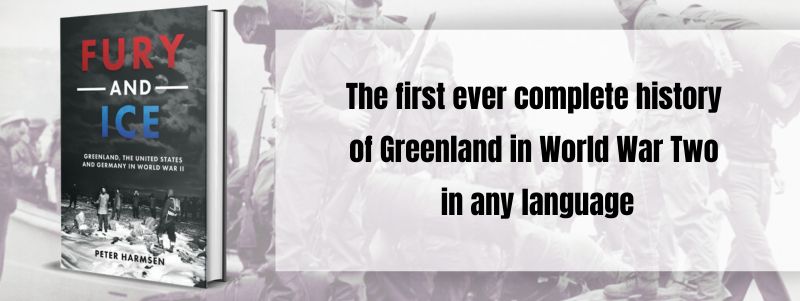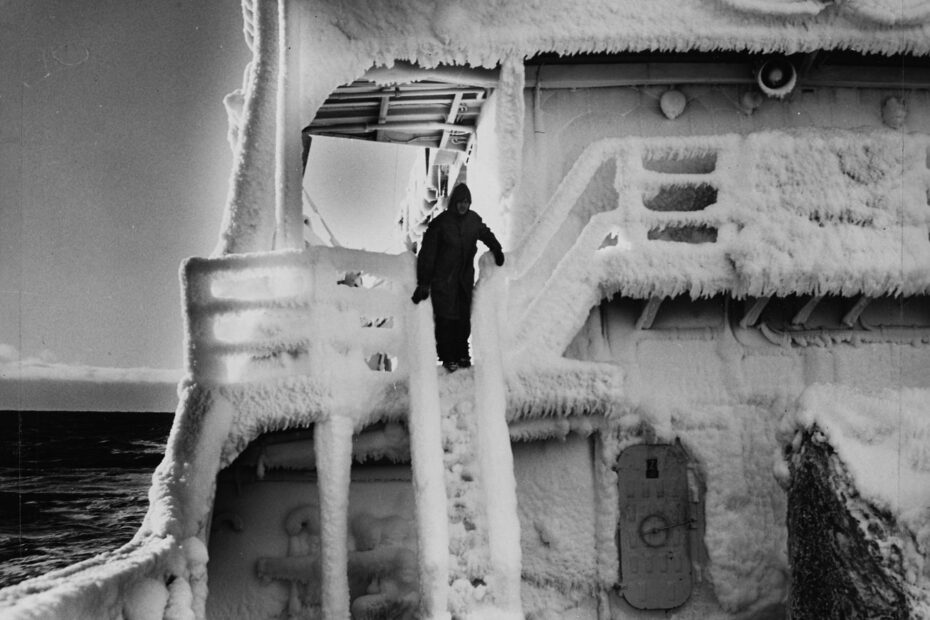By Script Books | 4 min read
In frozen Greenland, far from the battlefields of Europe, Americans and Germans are locked in a deadly cat-and-mouse game over access to vital weather data that will help determine the war. Read the extract below for a glimpse of events behind the icy façade where espionage meets meteorology.
Chapter Two: Terra Incognita No Longer 1900–1939
Greenland was an inescapable geographical fact for the Americans. Taking up almost as much space as the 26 states east of the Mississippi combined, it was impossible to ignore. At the same time, Greenland’s importance was not lost on a rapidly expanding nation on the verge of great power status which was beginning to think about foreign policy in global terms. As the 20th century dawned, the island’s pivotal position in the North Atlantic, as a giant shield protecting the New World from the Old, was obvious to anyone with access to an atlas. Geologically a part of the Western Hemisphere, yet stretching further east than Iceland, its strategic location which could prove valuable in times of both war and peace, was remarked upon by a growing number of influential writers and thinkers.
Much of this renewed interest in Greenland was driven by technological advances, or even visions about where technology would be in the foreseeable future. In 1916, as much of the world was embroiled in a devastating conflict, the polar explorer Robert E. Peary, who was also an officer in the US Navy, noted that “with the rapid shrinking of distances in this age of speed and invention, Greenland may be of crucial importance to us in the future.” In American hands, he argued, Greenland “may be a valuable piece in our defensive armor. In the hands of hostile interests it could be a serious menace.” Stranger things have happened, he added, than that an American-controlled Greenland “might furnish an important North Atlantic naval and aeronautical base.” The idea of the island as a stopover not just for ocean-going vessels, but also for airplanes, was precocious at a time when no one had yet succeeded in crossing the Atlantic inside a cockpit, but it was not unique, as it was shared by far-sighted people in not just the United States, but also Canada.
Just a few months after Peary committed his thoughts to paper, in April 1917, John Douglas Hazen, the Canadian minister of the naval service, remarked that “with the improvement in aviation […] that will follow the war it is within the bounds of probability that before long airships may at regular intervals cross the Atlantic, in which case Greenland would prove a convenient and important location on a Trans-Atlantic aerial route.” It was by no means coincidental that Peary was a prominent figure in the public American debate about what to do with Greenland. Waxing lyrical about the island as “the pendant brooch of the glittering necklace of snow and ice which circles the North Pole,” he had led several expeditions across the largely unexplored northern part of the island. An important purpose of these missions had been to chart areas where no man had ever before set foot in the hope that by doing so, he could help bolster US claims to territory where Danish authority was tenuous. It was only natural, he argued, for “geographically Greenland belongs to North America.”
This took place against the backdrop of what, in American eyes, was general indifference among Danes towards the island. “[Denmark] gives very little attention to the development of the resources of Greenland, which is practically terra incognita,” the US envoy to Copenhagen, Maurice Francis Egan, had written in a report to Washington in 1910.7 It was, in the minds of most Danes, “waste territory,” he added in another report. Egan saw opportunity in this state of affairs, suggesting an imaginative if complicated deal, in which Denmark was to hand over Greenland to the United States in return for a number of southern Philippine islands. Denmark was then immediately to pass on its newly won Pacific possessions to Germany in exchange for territory in Schleswig lost in the German–Danish war of 1864.
The proposal never got anywhere, as it involved too many moving parts, and would have given Germany a dangerous foothold in East Asia. While heading down a diplomatic cul-de-sac with his globe-spanning land deal, Egan was, on a more realistic level, deeply involved in negotiations over another Danish territory, the Virgin Islands in the Caribbean. This was a part of the world that was rapidly gaining strategic importance from a US perspective due to the Panama Canal, built between 1904 and 1914, and the cash-starved Danish government was becoming more inclined to sell. In an indirect manner, Greenland also became a topic in these talks. This was due to the government in Copenhagen, which made it a precondition for the sale of the Virgin Islands that the American government did not object to Denmark extending its political and economic interests to all of Greenland. As a result, when the handover of the Caribbean islands was finally carried out in 1917, a side effect that was not much noted at the time, was a significant US concession: Greenland in its entirety was recognized as sovereign Danish territory.
While the dreams expressed by Peary and others of formal American control of Greenland or parts of it were thus crushed, the island’s position within the US
sphere of influence was nevertheless soon reinforced. This happened in May 1920, when the British government contacted its Danish counterpart, requesting that it be granted the right of first refusal if Denmark was ever to attempt to sell Greenland. “The geographical position of Greenland makes the question of ownership a matter of great importance to the British Empire as a whole and to Canada in particular,” Lord Curzon, the British foreign secretary, told the Danish envoy to London. The terra incognita no longer US government reacted promptly, telling both London and Copenhagen that such a British privilege, or any similar privilege extended to any other third party, would be out of the question, owing to Greenland’s proximity to the United States.
Although the Monroe Doctrine was not mentioned explicitly in this communication, its principles were nevertheless the unspoken rationale underlying the American position, making this the first time that the US government signaled in unmistakable terms that Greenland was covered by this foundational document of American foreign policy, even though it happened with a significant delay, almost a century after it had been announced. It was significant that in its messages to Britain and Denmark the US government ruled out prioritizing any “third government,” not just a European one, when considering a sale of Greenland, as this also implied that a handover to Canada would be unacceptable. At the end of the same decade, in 1929, US Secretary of State Frank B. Kellogg stressed the US position further, making clear in a message to American envoys in capitals south of the Rio Grande that the Monroe Doctrine applied to the entire Western Hemisphere, not just Latin America. In this way, three decades into the 20th century, the groundwork had been laid for future practical steps by the United States government to deny access to Greenland for any European powers and, just as importantly, to establish its own presence there.


 Follow
Follow